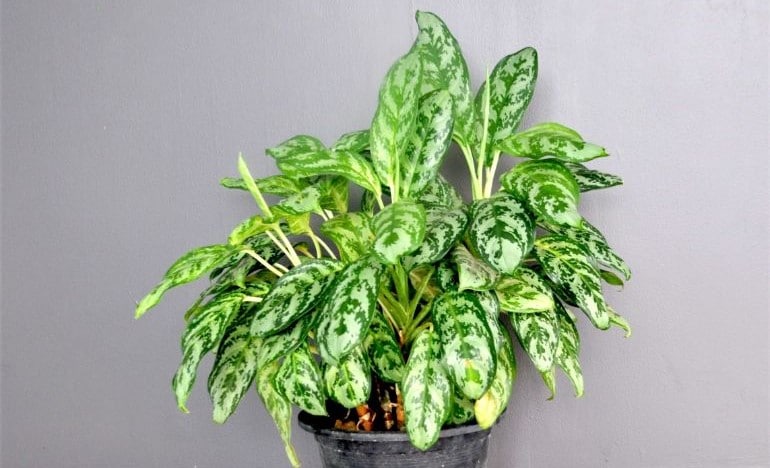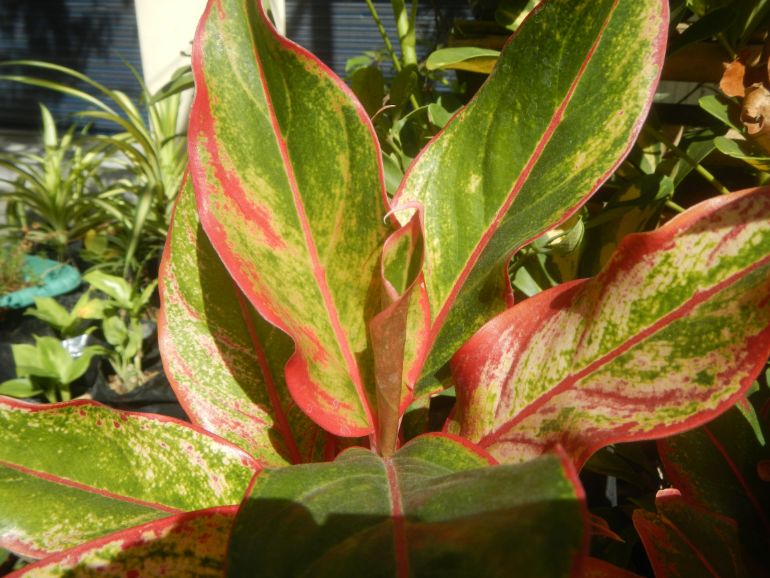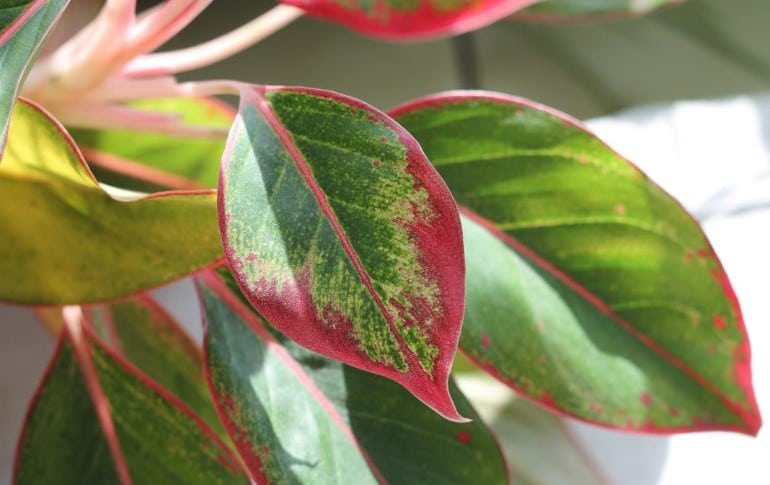Aglaonemas, also known as Chinese evergreens, are popular houseplants with eye-catching, beautifully patterned foliage. Though they are exceptionally hardy and low-maintenance indoors, it’s not uncommon for their lovely leaves to curl. In this article, we’ll look at the causes of Chinese evergreen leaves curling and how to fix the problem.
Chinese evergreen leaves curl due to excess water loss or insufficient water delivery to the leaves. Lack of water due to underwatering, or root damage caused by overwatering are the most likely causes. Water loss due to high temperatures, low humidity, or pests are also common causes.
The key to identifying the cause of Chinese evergreen leaves curling is to check the conditions your plant is growing in and look for other symptoms of a problem. Careful inspection usually leads to the cause being identified and you can then make some adjustments and get your plant back to perfect health.
Overview Of Why Your Chinese Evergreen’s Leaves Are Curling
Chinese evergreens are wonderful beginner plants and one of the most commonly used office plants for their looks, hardiness, and modest growth. It’s one of the few houseplants that truly thrive in low-light conditions.
These decorative, medium-sized Asian natives have short stems and elongated, narrow leaves with fancy veining. There are several varieties of Aglaonema in colors of dark green, red, and silver.
It’s easy to care for Chinese evergreens indoors – they are tolerant of minimal light and benign neglect. Basically, if conditions are comfortable for you, they’ll be happy too.
Even so, it’s not unusual to see their foliage become wavy or curled. There are a surprising number of potential causes, but don’t be alarmed! Simply go down the list as you rule out each possibility.
Curled leaves may straighten back to their former appearance once you’ve solved the problem; but, even if affected leaves don’t recover, new foliage will return to normal.
Aged Foliage
As a Chinese evergreen’s elegant leaves age, they may curl as the plant withdraws its energy. This most often happens with lower, older leaves. Have no worries if curling is limited to an occasional retired leaf.
Overwatering
Overwatering is common with Chinese evergreens. Curled leaves are one of the lesser symptoms – yellowing and leaf loss are the classic early signs. If the situation continues, root rot and death will result.
It can be difficult to know whether over or underwatering is the culprit because they produce similar effects. Nevertheless, overwatering is the more common (and more dangerous) imbalance.
Chinese evergreens prefer dry soil rather than an overly moist mix. They need a well-draining medium that stays slightly damp: the roots drown in soil that stays too wet. Let the top inch or so of the mix dry before rewatering.
Don’t water on a schedule, but use your finger or a wooden implement to monitor the soil’s moisture. Learning how much the pot weighs when hydrated versus when dry is a convenient way to tell when it’s time to water.
Note: If the container is over 10 inches in diameter, let the soil dry further down, to about the bottom half or quarter. A reliable moisture meter is useful when checking a large pot.
If you suspect overwatering, unpot the plant and check for rot. Healthy roots will be pale and firm and have an earthy smell; diseased roots are dark, mushy, and foul-smelling. If you find trouble, trim away the infected parts and add fresh (dry) soil. Good air circulation will encourage the soil to dry faster.
Cut back on watering in winter! These plants don’t go dormant, but they do slow water consumption during the cool season.

Underwatering
If your Chinese evergreen’s soil gets too dry, the foliage will curl and wilt. There’s a point of no return when the leaves dry out and become crispy, but if they’re still soft there’s a chance of recovery. The leaves should soon start to perk up and straighten out after being watered.
Soil that has dried out completely poses an extra challenge because a bone-dry mix resists hydration. This is a good time to bottom water by sitting your plant in a shallow reservoir of water and letting it soak up thoroughly. If you top water, give your plant a few doses spaced minutes apart.
Note: Remember not to let your plant sit in water after it has soaked! Empty all reservoirs and caches.
Humidity
Though Chinese evergreens are tolerant of average humidity, persistently dry air can result in Chinese evergreen leaves curling. The leaves may also droop and growth may slow.
Increasing the plant’s humidity levels will naturally fix the issue. Foliage that hasn’t dried may recover.
Here are factors to consider:
- Chinese evergreens don’t usually need a humidifier, but higher humidity can give them a boost.
- Artificial heat drives moisture from the air, so consider taking steps to provide more humidity over the cold months.
- Grouping plants together or putting water-filled trays near your Chinese evergreen can modestly increase local humidity.
- To save space, sit the pot on pebbles in a tray or saucer to elevate the soil above the waterline.
Temperature
Chinese evergreens are warmth-loving tropicals that are easily stressed by temperature extremes: the effects include curling as well as dark spots. Damage shows up in a week to 10 days.
The plant’s ideal range is between 70 to 80 °F (21 to 27 °C). Even slightly lower temperatures can retard growth.
Hot or cold drafts or even a brief chill can damage an Aglaonema. The plant is in the danger zone once temperatures dip below 60ºF (º16C). New foliage has a slightly higher resistance to cold.
Interestingly, the ubiquitous “Silver Queen” variety is one of the most sensitive to cold. If your environment is on the chilly side, try these newer hybrid Aglaonemas bred for cold resistance:
- “Emerald Star”
- “Jewel of India”
- “Stars”
Light
The ability to thrive in low light is one of the Chinese evergreen’s attractions – their trouble with lighting comes mainly from too much. Direct sunlight can result in Chinese evergreen leaves curling, and it will also scorch their tender foliage.
An ideal solution is to move the plant to a bright location out of direct sun. The plant also does well under artificial sources like fluorescents.
You won’t get burned leaves back, but you’ll see normal foliage once you correct the light situation. You can read more about assessing light levels for houseplants in this article. This is one of the most important factors in growing healthy houseplants, so it’s well worth getting to know what your plants like.

Unfavorable Water Quality
This isn’t the most common reason for leaf curling, as Chinese evergreens aren’t hyper-sensitive about water purity. Still, it can happen if your tapwater is highly mineralized or contains chemicals. It’s best to dechlorinate municipal tapwater.
If you’ve eliminated other causes of your plant’s curling, consider switching to a more purified water source. Rainwater is excellent; spring or filtered water is also good.
Overfertilization
Chinese evergreens aren’t heavy feeders. They generally thrive without added fertilizer if their soil includes sufficient organic matter.
Problems related to nutrition usually mean overfeeding: the buildup of residual nutrient salts can toxify the soil and damage the roots. This can result in Chinese evergreen leaves curling and browning as the roots become unable to deliver what the plant needs.
- Dilute the fertilizer to half or a quarter of the label’s recommendation.
- Apply just once or twice during the growing season.
- Don’t fertilize during the cool months.
- Inorganic formulas can work well, but organic fertilizers are gentle and safe.
- Consider watering before fertilizing to avoid an uprush of chemicals into the plant.
To prevent residual buildup, flush the soil regularly when you water. Let excess water flow through the soil and out the drainage holes. If you suspect overfertilization, flush the soil several times.
Undernutrition
It’s possible (but unlikely) that your Chinese evergreen’s foliage is curling from a lack of nutrition. A modest fertilization routine will prevent such problems as long as the pH range is suitable.
A slightly acidic soil aids your Aglaonema’s nutrient absorption; a mix that is too alkaline can actually inhibit use of available nutrition.
If you think your plant is stressed by a lack of nutrients, use a simple test to check the pH. Adding organic material is a simple and natural solution.
Pest Infestation
Pest damage can result in Chinese evergreen leaves curling, along with mottled spotting and other disfigurements. The “good” news is that you can quickly determine if you have an infestation.
Your Chinese evergreen’s most common pests are aphids, spider mites, and mealybugs or other forms of scale. A magnifying glass is handy as some of the potential pests – especially spider mites – are very small. Check hiding places underneath leaves and in the plant’s joints.
It’s a good idea to routinely inspect for pests: it’s easier to eradicate an infestation if you catch it early.
Each of these pests can be controlled with mild treatments of insecticidal soap or horticultural oil, including Neem oil. A dilute (rubbing) alcohol spray or a dusting of diatomaceous earth (DE) is also safe and effective … individual critters can be literally wiped out with an alcohol-soaked cotton ball.
Disease
Moist conditions encourage fungal diseases, but Chinese evergreens can fall prey to bacterial or viral infections too. Common symptoms include leaf curling, wilting, and yellowing.
Fungal infections can look bad but have a hopeful prognosis – often drier conditions or just keeping water off the leaves curtails the problem.
Isolate the plant to avoid further contamination, and remove and safely dispose of infected foliage. See the plant isn’t stressed as it fights off the ailment. Fungicides and other commercial treatments are available but not always completely effective. Most diseases are opportunistic: keeping your plant healthy is the best course.
Last Word
Whilst Aglaonemas can have slightly wavy leaves, sudden curling is usually a bad sign. The good news is that most causes of Chinese evergreen leaves curling can be fixed if you take a little time to inspect your plant and fix any problems that you find.
If you’d like to learn how to master the art of growing Chinese evergreens, check out some of my other articles listed below. Alternatively, check out my book “Houseplants Made Easy” to learn everything you need to know to grow beautiful houseplants that thrive year after year.

